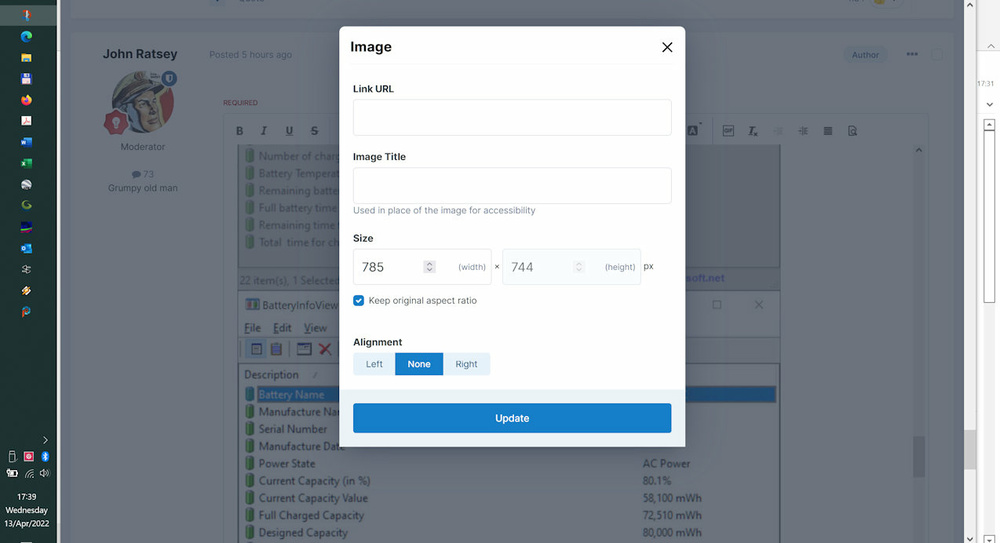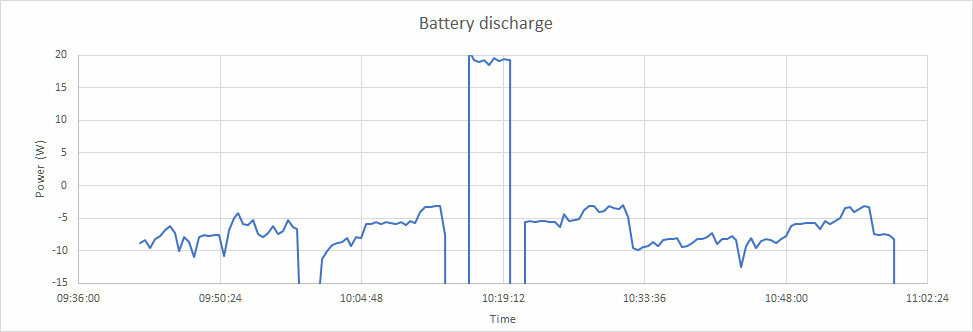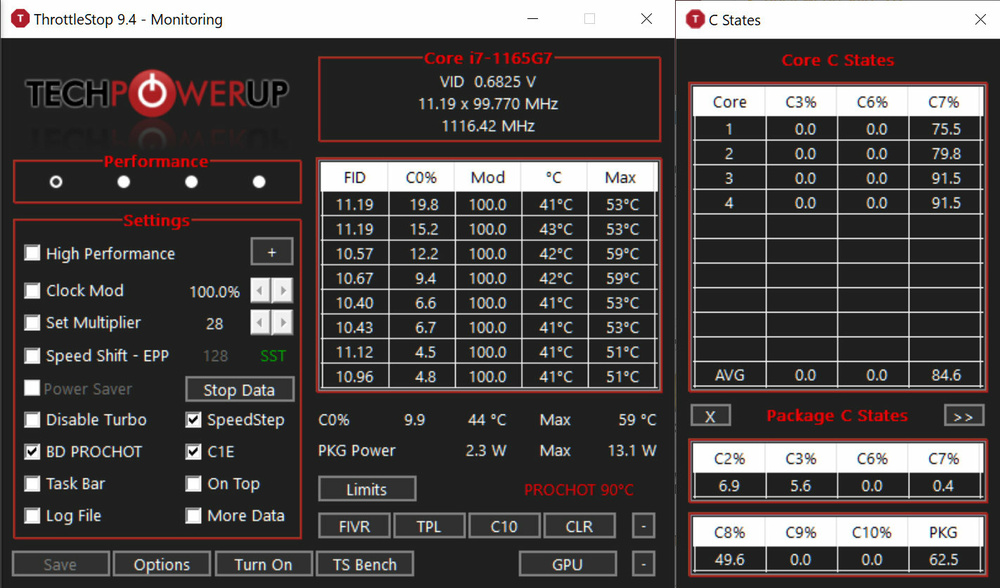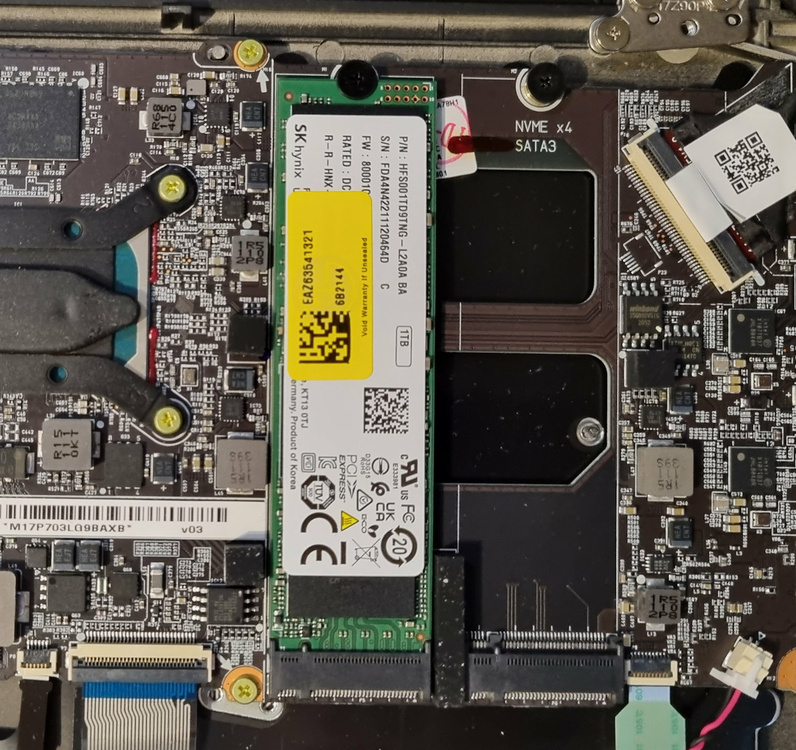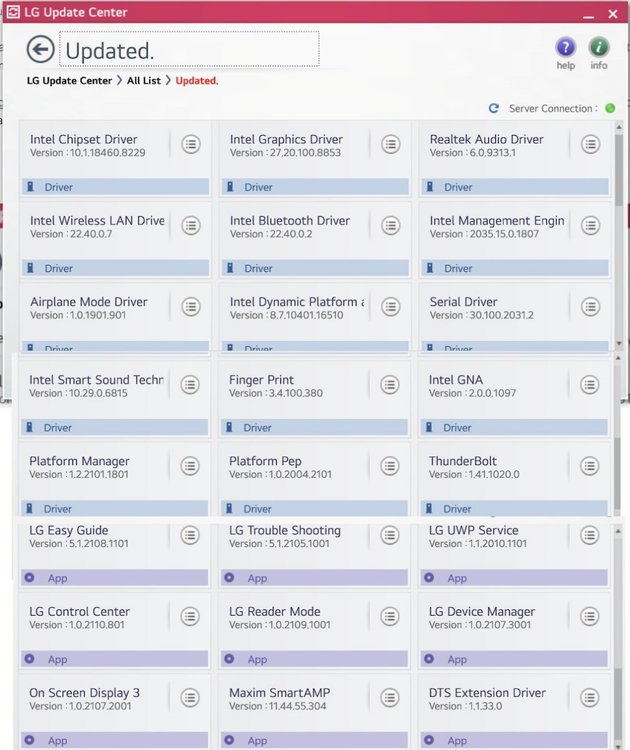-
Posts
208 -
Joined
-
Last visited
Content Type
Profiles
Forums
Events
Everything posted by John Ratsey
-
While exploring other parts of this forum I came across this power saving guide which has been copied from NBR (hence no graphics) and has many relevant suggestions for trying to reduce the power consumption.
- 93 replies
-
- dopus
- directory
-
(and 50 more)
Tagged with:
- dopus
- directory
- opus
- file
- explorer
- zenbook
- 2022
- notebookcheck
- pc
- games
- fps
- performance
- laptops
- clevo
- nh55jnpy
- nh55jnrq
- nh55jnnq
- sound
- tutorial
- guide
- image quality
- quality
- blurry
- images
- storage
- storage limits
- laptops
- desktops
- desktop replacement
- janktop 4
- efgxt.net
- transfer
- notebooktalk.net
- gta
- grand theft auto
- rockstar
- open world
- crime drama
- m18x
- nvme
- mxm
- r2
- upgrade
- what laptop should i buy
- template
- opera gx
- chrome
- edge
- brave
- firefox
- dell precision 7760
- dell precision m6700
-
My formula to convert 100mWh is divide by 1000 to convert from mW to W and then multiply by 60 to remove the hr/min which then just leaves the unit as Watts. I have a dim recollection of doing this type of exercise either at school or at university both of which were a long (>50 years) ago. That's an interesting observation which indicates that the battery calibration isn't quite right. Samsung used to include a battery calibration in the BIOS so that users could, every few months, fully drain the battery and then fully recharge it in order to reset the voltage - capacity relationship. Windows won't allow the battery to be fully drained as a low capacity will trigger hibernation or shutdown but the workaround is to open the BIOS setup and leave the computer until it's empty. I'm wondering if some of my missing battery capacity would reappear if I did this, but it's not a priority as the battery is effectively only a backup against mains failure. Something else I should mention is that I was just using the touchpad during my time on battery and I had no problems with scrolling etc.
- 93 replies
-
- dopus
- directory
-
(and 50 more)
Tagged with:
- dopus
- directory
- opus
- file
- explorer
- zenbook
- 2022
- notebookcheck
- pc
- games
- fps
- performance
- laptops
- clevo
- nh55jnpy
- nh55jnrq
- nh55jnnq
- sound
- tutorial
- guide
- image quality
- quality
- blurry
- images
- storage
- storage limits
- laptops
- desktops
- desktop replacement
- janktop 4
- efgxt.net
- transfer
- notebooktalk.net
- gta
- grand theft auto
- rockstar
- open world
- crime drama
- m18x
- nvme
- mxm
- r2
- upgrade
- what laptop should i buy
- template
- opera gx
- chrome
- edge
- brave
- firefox
- dell precision 7760
- dell precision m6700
-

Posting Images to the forum - Feedback Thread!
John Ratsey replied to Reciever's topic in Internal Announcement Discussion
Thanks. I've been right-clicking on an image and looking for an option but didn't think of double-clicking. Nonetheless, the image as displayed on my screen (2560 pixels wide) seems to have been upscaled as instead of occupying about 30% of my screen width, it's nearer 60%. Embedded thumbnails which will enlarge when clicked on would be my preference if the forum software supports this feature. -

Posting Images to the forum - Feedback Thread!
John Ratsey replied to Reciever's topic in Internal Announcement Discussion
I would like more control over how images are presented when I upload them. There seems to be upsizing when embedding into a discussion. I've just posted something here and the graphics are much larger than needed to convey the information so they take up more space than needed. I tried resizing before uploading but it didn't make a significant difference. The first graphic (BatteryInfoView) was 785 pixels when uploaded which is legible but not too big but it's displaying as much bigger. Am I missing something here? Can I embed a thumbnail image in the appropriate place which will enlarge to the uploaded size when clicked on? -
That's an interesting unit: mWh/min! By my reckoning 1 mWh/min = 0.06W so all those states of idleness are low drain (but subject to Windows deciding it's time to do some housekeeping). 100mWh/min is 6W which is the number I chucked into the air a few days ago as a reasonable target power drain under light usage. Perhaps Windows has settled down? It might previously have been doing indexing during any idle moments. I have also carried out some more testing on my Gram 17. I had previously disabled the battery saver option to check the fully charged capacity. It's only 72.5Whr but this was a pre-owned Gram 17 so I don't know how the battery was treated. I'll wait and see of the reported full charged capacity stays there or reverts to 80% of that number when the computer next starts up. Then I needed to drain the battery below the 80% level for the battery saver setting to become effective so I let BatteryInfoView do some logging which resulted in this graph: I spent most of the time composing a long email but I had Firefox (with the innumerable tabs) open and was intermittently looking for information. I also went away from the computer at intervals. The display was at about 1/2 brightness and the graph confirms my previous observation of an average power drain of about 8W when running on battery with Firefox open. I'm happy with this as my Gram 17 will be rarely used away from my desk.
- 93 replies
-
- dopus
- directory
-
(and 50 more)
Tagged with:
- dopus
- directory
- opus
- file
- explorer
- zenbook
- 2022
- notebookcheck
- pc
- games
- fps
- performance
- laptops
- clevo
- nh55jnpy
- nh55jnrq
- nh55jnnq
- sound
- tutorial
- guide
- image quality
- quality
- blurry
- images
- storage
- storage limits
- laptops
- desktops
- desktop replacement
- janktop 4
- efgxt.net
- transfer
- notebooktalk.net
- gta
- grand theft auto
- rockstar
- open world
- crime drama
- m18x
- nvme
- mxm
- r2
- upgrade
- what laptop should i buy
- template
- opera gx
- chrome
- edge
- brave
- firefox
- dell precision 7760
- dell precision m6700
-
Thanks for your update. I've also concluded from a couple of tests today that the transition from S3 sleep to hibernation isn't working. This could well be a long-standing issue with Windows. The observation here is that when the computer wakes from sleep in order to hibernate it forgets to hibernate and restarts the timer for sleeping. Perhaps that's the strength of S0 sleep: The computer isn't properly sleeping and therefore has the resources awake to go into hibernation when the time comes. Hibernation should take zero, or very close to zero (eg checking to see if the power button is pressed) power. Microsoft's explanation of the different sleep states might throw a little light on what is using power. Do you have anything connected to the computer when running on battery? If so, the USB hub may be staying active even if the computer is sleeping. Or it might be the SSD interface. Unhide the various link state power managements options and set them to be the lowest when on battery. BTW: I've just noticed another bug / feature: I've had the Extend Battery Life option enabled in the LG Control Centre and this has resulted in the computer reporting that the 80% charge is actually 100% which suggests I've got a dying battery (Full Charged Capacity 59,390 mWh) rather than the % of the actual capacity. I've not seen that on other computers - my Galaxy Book Pro with battery saver enabled says 84%.
- 93 replies
-
- dopus
- directory
-
(and 50 more)
Tagged with:
- dopus
- directory
- opus
- file
- explorer
- zenbook
- 2022
- notebookcheck
- pc
- games
- fps
- performance
- laptops
- clevo
- nh55jnpy
- nh55jnrq
- nh55jnnq
- sound
- tutorial
- guide
- image quality
- quality
- blurry
- images
- storage
- storage limits
- laptops
- desktops
- desktop replacement
- janktop 4
- efgxt.net
- transfer
- notebooktalk.net
- gta
- grand theft auto
- rockstar
- open world
- crime drama
- m18x
- nvme
- mxm
- r2
- upgrade
- what laptop should i buy
- template
- opera gx
- chrome
- edge
- brave
- firefox
- dell precision 7760
- dell precision m6700
-
Select the data > Format > Custom > hh:mm:ss . This displays only the time and the labels on the graph should use the same formatting unless set otherwise. Alternatively, if you want to keep the date in the data you can format the axis to apply the hh:mm:ss. I haven't tried checking if sleep automatically transitions to hibernation. I've had so many problems with Windows sleep crashing over the years that I manually select hibernation rather than discover that the computer has hung and work in progress has been lost. The other worry I have about Windows sleep is the unexpected wake-up although better thermal management reduces the likelihood of computers suffering melt-down in bags. However, I also remember that when I first got my Gram 17 and shut the display expecting it to go to sleep (which my little Galaxy Book Pro does very happily) the fan in the Gram 17 became very noisy when it should have gone off. Given that the fan exhaust is effectively blocked when the display is shut caused me to manually select hibernation. I've checked and it seems to be better behaved (perhaps the S3 fix has helped) but there's lingering doubt.
- 93 replies
-
- dopus
- directory
-
(and 50 more)
Tagged with:
- dopus
- directory
- opus
- file
- explorer
- zenbook
- 2022
- notebookcheck
- pc
- games
- fps
- performance
- laptops
- clevo
- nh55jnpy
- nh55jnrq
- nh55jnnq
- sound
- tutorial
- guide
- image quality
- quality
- blurry
- images
- storage
- storage limits
- laptops
- desktops
- desktop replacement
- janktop 4
- efgxt.net
- transfer
- notebooktalk.net
- gta
- grand theft auto
- rockstar
- open world
- crime drama
- m18x
- nvme
- mxm
- r2
- upgrade
- what laptop should i buy
- template
- opera gx
- chrome
- edge
- brave
- firefox
- dell precision 7760
- dell precision m6700
-
This says Ctrl-Alt-Shift-F7 is needed for the 2021 Gram. I've just got it to work by not trying to press all the keys together but pressing and holding first Ctrl then Alt then Shift and finally F7. However, I'm not planning to fiddle with any of the numerous extra settings without good reason. What CPU load are you seeing in Task Manager? Without Firefox running but with a few other things open I am seeing less than 1%. PS: Yes, the power drain was done in Excel. Rename the .txt file as .csv then all the columns will load correctly. I then added a column for the watts (milliwatts / 1000).
- 93 replies
-
- dopus
- directory
-
(and 50 more)
Tagged with:
- dopus
- directory
- opus
- file
- explorer
- zenbook
- 2022
- notebookcheck
- pc
- games
- fps
- performance
- laptops
- clevo
- nh55jnpy
- nh55jnrq
- nh55jnnq
- sound
- tutorial
- guide
- image quality
- quality
- blurry
- images
- storage
- storage limits
- laptops
- desktops
- desktop replacement
- janktop 4
- efgxt.net
- transfer
- notebooktalk.net
- gta
- grand theft auto
- rockstar
- open world
- crime drama
- m18x
- nvme
- mxm
- r2
- upgrade
- what laptop should i buy
- template
- opera gx
- chrome
- edge
- brave
- firefox
- dell precision 7760
- dell precision m6700
-

Laptop/notebook news and announcements discussion thread
John Ratsey replied to Papusan's topic in Tech News
For thin notebooks the Turbo feature brings little benefit because of the limited ability to dissipate heat. I've just done an experiment with my LG Gram 17 (i7-1165G7) set on the Optimised cooling profile (when the fan is barely audible) and compared the wPrime times for Maximum processor state of 100% (turbo mode enabled) and 99% (turbo mode disabled): For 100%, wPrime 32M = 7.15s, 1024M = 305.7s; and for 99% wPrime 32M = 9.6s, 1024M = 311.2s. This highlights the significant difference turbo brings for a task that takes no more than a couple of seconds but for anything more challenging then the CPU is running at non-turbo speed for thermal reasons. A pending task is to see the effect of using LG's Performance cooling mode. There's actually plenty of room in the notebook for a bigger cooling system but that would push it over 3lb weight which, I suspect, was one of the design team's objectives. Nonetheless, the limited CPU performance doesn't prevent the notebook from feeling very responsive. Fast RAM and fast SSD are important components. -
Your research has prompted me to test my Gram 17. However, I'll first note that the 6W is a theoretical number based on getting 10 hours on the battery assuming 60Whr of usable capacity. I unplugged the mains and let BatteryInfoView log the battery discharge. I've changed the logged power to Watts for clarity and would add some comments on the graph below which crops off some extreme values such as you observed (caused, I assume, by the way the power drain is calculated). About half way through I decided to test a big RavPower powerbank that claims to deliver up to 30W. It was putting just under 20W into the battery and the balance would be powering the computer. However, given that the computer thinks it is running on the mains, manual tweaking of settings would be needed to use a powerbank efficiently. The display was on about half brightness and I tried different situations of what was running. I wouldn't want to go lower without reducing the room brightness (it's sunny outside today). My measured power drain is mainly between 3W and 10W. However, less than 5W is only achieved when I leave the computer long enough for the display to turn off but when I closed Firefox (with >50 tabs open) then I could get below 6W. With Firefox open the drain was around 8W. You mentioned Modern Standby which I don't think is enabled on my Gram 17 as no value is set in the registry. Modern Standby's desire to keep connected is well known for blocking entry into the lower power states. As we've already noted, my Gram 17 appears to have an LG customised version of Windows so they probably realised that Modern Standby would trash their claims of battery run time but you appear to have a non-customised version of Win 11. One test you can do is to run ThrottleStop which can show the C States being used by the CPU (the bigger the number then the lower the power). Press the C10 button to see the C States. Below is what I saw after running for several minutes on battery with Firefox and all those tabs open. BTW, I found a very useful bit of software called Power Settings Explorer which let me add missing features to my Power Options (run as Administrator, find what you want on the list and double-click on the entry in the Settings list to go to the registry entry then change the Attribute value to 2 to make it visible). This software may help with stopping Modern Sleep (this might be the Allow Hybrid Sleep entry).
- 93 replies
-
- dopus
- directory
-
(and 50 more)
Tagged with:
- dopus
- directory
- opus
- file
- explorer
- zenbook
- 2022
- notebookcheck
- pc
- games
- fps
- performance
- laptops
- clevo
- nh55jnpy
- nh55jnrq
- nh55jnnq
- sound
- tutorial
- guide
- image quality
- quality
- blurry
- images
- storage
- storage limits
- laptops
- desktops
- desktop replacement
- janktop 4
- efgxt.net
- transfer
- notebooktalk.net
- gta
- grand theft auto
- rockstar
- open world
- crime drama
- m18x
- nvme
- mxm
- r2
- upgrade
- what laptop should i buy
- template
- opera gx
- chrome
- edge
- brave
- firefox
- dell precision 7760
- dell precision m6700
-
Not quite identical as it's 16" but has the same resolution as the Gram 17 notebook. See here.
-
I'd personally opt for a better known brand such as this Amazon charger which is looks a bit bigger but is under 4oz. Items on the Amazon UK website may show as unavailable to you because they won't ship to the US. Some blinds would be a work-around but I learnt many years ago when notebook screens were much less bright to avoid sitting with my back to a window.
-
The new charger is similar to the 65W charger that came with my 2021 Samsung Galaxy Book Pro whereas my LG Gram has the black charger with the separate AC cable. However, it looks as if the cable in the new LG charger is integrated whereas the Samsung charger has a USB-C socket and separate cable. I prefer the latter as often cables die before the charger. A separate cable also means that if the computer is further from the AC outlet than the supplied cable can reach then there's the relatively cheap fix of getting a longer USB-C power cable. There's a very big selection of other suitable chargers. Here's one I bought recently that has some extra sockets which can be used for charging other devices without using the computer. The new smaller chargers use Gallium Nitride electronics which generate less heat than Silicon. Heat dissipation has been a bigger problem than shrinking the electronics. More here.
-
I assumed you appreciated that the $1,100 was clear-out pricing getting ready for the new model. We've got our own thread about the 2022 model. I would assume that the non-Nvidia model will appear at whatever price the P series was when it arrived and the dGPU will add more to the price tag (and reduce the time on battery). Given that you've got the generous returns window you've probably got time to see the new prices and be sure that you need the anti-glare screen (and ideally find out if it significantly degrades the sharpness) before you have to make your return. Yes, you need a full USB-C cable and charger for the power delivery system to work (the chips at each end have to talk to each other and find out the highest voltage supported by both devices). Power-delivery capable power banks also exist if you want a longer time away from a power socket. The power supply options definitely apply to my Galaxy Book Pro 13 and probably most (all?) recent notebooks which use a USB-C power supply (recent goes back a few years as my Dell Latitude 7370 would run on other USB-C supplies). I'm wondering what difference there is between the 17Z90P and 17Z95P versions. Does the 17Z95P come with Win 11 pre-installed?
- 93 replies
-
- dopus
- directory
-
(and 50 more)
Tagged with:
- dopus
- directory
- opus
- file
- explorer
- zenbook
- 2022
- notebookcheck
- pc
- games
- fps
- performance
- laptops
- clevo
- nh55jnpy
- nh55jnrq
- nh55jnnq
- sound
- tutorial
- guide
- image quality
- quality
- blurry
- images
- storage
- storage limits
- laptops
- desktops
- desktop replacement
- janktop 4
- efgxt.net
- transfer
- notebooktalk.net
- gta
- grand theft auto
- rockstar
- open world
- crime drama
- m18x
- nvme
- mxm
- r2
- upgrade
- what laptop should i buy
- template
- opera gx
- chrome
- edge
- brave
- firefox
- dell precision 7760
- dell precision m6700
-
I suspect tht the Win 11 is a standard installation whereas Win 10 has been customised. I'm sure a little research will reveal what registry edit is needed to reveal the missing advanced power settings. I've noticed the fan at times but only if there's no significant ambient noise. It's quiet compared with the XPS15 I had on my desk last week being prepared for rehoming. A consequence of the low fan noise is the low power limit imposed by the BIOS so the CPU will only run at full speed for a short period before being throttled. I think the photo below has the answer: The slot is marked "NVME x4 SATA3." A SATA SSD has two notches and a SATA-only slot has two keys whereas an NVME slot has one key. SATA will fit into an NVME slot but not the other way round. Regarding your earlier comment about the small PSU, the PSU provided with the UK version of the Gram 17 is significantly larger than the 65W PSU provided with the Samsung Galaxy Book Pro which looks like an over-sized USB-C phone charger. However, if you want to travel light then there's a good selection of compact 45W USB-C chargers which are fine for powering the Gram 17 and charging the battery at moderate rate. The 65W charger allows a faster charging rate. The computer will complain about but run on a 25W charger - it might need to draw on the battery under maximum CPU load.
- 93 replies
-
- 1
-

-
- dopus
- directory
-
(and 50 more)
Tagged with:
- dopus
- directory
- opus
- file
- explorer
- zenbook
- 2022
- notebookcheck
- pc
- games
- fps
- performance
- laptops
- clevo
- nh55jnpy
- nh55jnrq
- nh55jnnq
- sound
- tutorial
- guide
- image quality
- quality
- blurry
- images
- storage
- storage limits
- laptops
- desktops
- desktop replacement
- janktop 4
- efgxt.net
- transfer
- notebooktalk.net
- gta
- grand theft auto
- rockstar
- open world
- crime drama
- m18x
- nvme
- mxm
- r2
- upgrade
- what laptop should i buy
- template
- opera gx
- chrome
- edge
- brave
- firefox
- dell precision 7760
- dell precision m6700
-
Thanks for the pointer to Explorer Patcher. I'll keep an eye on how it evolves although it's also possible that M$ may modify Win11's behaviour. You could also try changing the touchpad's sensitivity setting to see if it helps with the remaining problems. And I'll be interested to hear the outcome of your battery drain investigations. One measure I've used in the past is to cap the maximum CPU speed as the turbo mode uses a lot more power to provide a small improvement in speed. However, the CPU settings (and others) are missing from the advanced power options so tweaking will be needed to un-hide those settings or use software such as ThrottleStop.
- 93 replies
-
- dopus
- directory
-
(and 50 more)
Tagged with:
- dopus
- directory
- opus
- file
- explorer
- zenbook
- 2022
- notebookcheck
- pc
- games
- fps
- performance
- laptops
- clevo
- nh55jnpy
- nh55jnrq
- nh55jnnq
- sound
- tutorial
- guide
- image quality
- quality
- blurry
- images
- storage
- storage limits
- laptops
- desktops
- desktop replacement
- janktop 4
- efgxt.net
- transfer
- notebooktalk.net
- gta
- grand theft auto
- rockstar
- open world
- crime drama
- m18x
- nvme
- mxm
- r2
- upgrade
- what laptop should i buy
- template
- opera gx
- chrome
- edge
- brave
- firefox
- dell precision 7760
- dell precision m6700
-
I've got a 2TB external SSD so I copy everything I might need from the big computer onto that and then copy files onto the little computer as an when needed. Then, before heading home, I copy anything that's been changed back to the SSD. Quite often on my travels the network connectivity is poor and sometimes non-existent so backing up to the www is less reliable than using local storage. I've just replied to your comments on the Gram 17 and one thought I've just had is that you should be able to use the dual SSD capability of that computer to have a primary SSD and a mirror SSD.
-
That's good value. There's also some clear-out pricing on this side of the pond but in British pounds instead of US dollars (but our 20% VAT accounts for much of the difference). Personally, I think the 1TB SSD is more useful than the slightly faster CPU which probably hits the power limit a bit quicker. It is an unusual display resolution but provides more sharpness than FHD while not going all the way to QHD. I've just checked and I'm also on 175% scaling. I've also got my older software where I've had to fiddle with the High DPI Settings in the program properties to find the best compromise. Overall, I like the display, particularly the sharpness and the 16:10 aspect ratio. The glare problem I was having a couple of weeks ago has diminished as the sun has got higher in the sky. My hands and fingers have got accustomed to the offset keyboard and I've got NumLk off so the numpad becomes a navigation pad. I haven't used the trackpad much as I've got an external mouse but one suggestion for the two finger scrolling is to try to hold the fingers together. I've had the problem of two fingers being interpreted as zooming on other computers so it's not specific to this computer. One work-around is to disable the pinch to zoom in the touchpad properties. I'm surprised by your observed battery drain which needs investigation. BatteryInfoView is simple free utility which makes it easy to check the current power usage in Watts. You'll be looking for no more than 6W to get a comfortable 10 hours on battery. Task Manager shows which software is using the resources (particular CPU and Disk) although tracking down which software is causing high activity by a background process can be challenging but Process Explorer will help. Also check the effect of display brightness on power drain. I'm wondering if OneDrive is one of the problems if it is continuously trying to sync files. It will be using the CPU and network connection plus stopping the SSD from sleeping. I've avoided Windows 11 as it won't let me put the Task Bar on the left side of the display so I can maximise the vertical space. I also appreciate the good selection of ports although most are having an easy life as I bought a Thunderbolt dock which is connected to the computer using a magnetic USB-C plug which seems to provide good connectivity (no adverse impact on the speed of an external SSD connected to the dock). Overall, the Gram 17 is fulfilling my objective of having a bigger screen than a 15.6" notebook while being easy to clear off my desk.
- 93 replies
-
- dopus
- directory
-
(and 50 more)
Tagged with:
- dopus
- directory
- opus
- file
- explorer
- zenbook
- 2022
- notebookcheck
- pc
- games
- fps
- performance
- laptops
- clevo
- nh55jnpy
- nh55jnrq
- nh55jnnq
- sound
- tutorial
- guide
- image quality
- quality
- blurry
- images
- storage
- storage limits
- laptops
- desktops
- desktop replacement
- janktop 4
- efgxt.net
- transfer
- notebooktalk.net
- gta
- grand theft auto
- rockstar
- open world
- crime drama
- m18x
- nvme
- mxm
- r2
- upgrade
- what laptop should i buy
- template
- opera gx
- chrome
- edge
- brave
- firefox
- dell precision 7760
- dell precision m6700
-
The Galaxy Book Pro 13.3 has only one slot (m.2 2230) whereas the Book Pro 15.6 has an empty 2280 slot (see notebookcheck review). OneDrive gets shown the door at the first opportunity. I'm more casual about backups than I used to be as storage drives are much more reliable. I wasn't aware that it could have a significant performance impact but I suspect that could depend on the size of the data files being changed.
-
It's good to see that LG hasn't messed up what is a good basic design. The anti-glare coating is the one feature that I'd like to have. I don't like white or silver keyboards because backlit lettering doesn't show up.
-
Here's my list of the updates: The sound appears to be working OK. I'm surprised that the BIOS doesn't get mentioned as I can't find any separate BIOS updater and it's version T2ZF0320 X64 dated 23rd April 2021. Most manufacturers have issued one or more updates during that time.
-
After a week of use my hands are happy with the keyboard even though it's offset. They action is good. I can occasionally hear the fan but it's very quiet compared with an XPS 15 which I've temporarily got alongside it. I've got a Thunderbolt dock connected using one of these magnetic connectors which means that disconnection doesn't cause any port wear. The very glossy screen is noticeable when sun is coming in the window but can be mitigated when there's a light background by turning up the brightness which I normally have at about 60%. I haven't discarded the possibility of getting an anti-glare screen protector although this may worsen what is a delightfully crisp display. A factory-applied slightly matte finish would be the best solution.
- 93 replies
-
- dopus
- directory
-
(and 50 more)
Tagged with:
- dopus
- directory
- opus
- file
- explorer
- zenbook
- 2022
- notebookcheck
- pc
- games
- fps
- performance
- laptops
- clevo
- nh55jnpy
- nh55jnrq
- nh55jnnq
- sound
- tutorial
- guide
- image quality
- quality
- blurry
- images
- storage
- storage limits
- laptops
- desktops
- desktop replacement
- janktop 4
- efgxt.net
- transfer
- notebooktalk.net
- gta
- grand theft auto
- rockstar
- open world
- crime drama
- m18x
- nvme
- mxm
- r2
- upgrade
- what laptop should i buy
- template
- opera gx
- chrome
- edge
- brave
- firefox
- dell precision 7760
- dell precision m6700
-

*Official Benchmark Thread* - Post it here or it didn't happen :D
John Ratsey replied to Mr. Fox's topic in Desktop Hardware
You were given a warning, not threatened with being banned. The warning about posting keys is valid as the last thing this forum wants is to be harrassed by a software company for posting their keys. You say they are free, but there could be conditions attached and the moderators are not in a position to to check the details. -
Both. I first got the solar panels and then quickly realised that the timing of domestic consumption was out of phase with the solar generation so the battery was added once one was available. In UK there's the added benefit of being able to charge the battery with cheap night time electricity. The result is that in the summer half of the year most of the consumption is met by solar generation (direct or via the battery) and during the winter most of the consumption is met by cheap night electricity stored by the battery. You can see the power flows at pvoutput but note that to see the battery data you have to select the right-most blob under the date selector (extended data). This week's good news is that after four years of waiting, Tesla's "intelligent" charging algorithm now appears to be looking at the weather forecast.
-
The MSI Z17 is a completely different machine made for a different purpose. The Gram 17 is for people who want a big screen for everyday tasks but many of the other 17" machines are 3D graphics workstations or gaming machines where a 17" display means a bigger chassis for holding the hardware. That's a valid point about using an eGPU connected via Thunderbolt. It's not something I've had a need to investigate but it merits discussion in the accessories forum. I assume that the technology has now been fairly well debugged.
- 93 replies
-
- dopus
- directory
-
(and 50 more)
Tagged with:
- dopus
- directory
- opus
- file
- explorer
- zenbook
- 2022
- notebookcheck
- pc
- games
- fps
- performance
- laptops
- clevo
- nh55jnpy
- nh55jnrq
- nh55jnnq
- sound
- tutorial
- guide
- image quality
- quality
- blurry
- images
- storage
- storage limits
- laptops
- desktops
- desktop replacement
- janktop 4
- efgxt.net
- transfer
- notebooktalk.net
- gta
- grand theft auto
- rockstar
- open world
- crime drama
- m18x
- nvme
- mxm
- r2
- upgrade
- what laptop should i buy
- template
- opera gx
- chrome
- edge
- brave
- firefox
- dell precision 7760
- dell precision m6700

